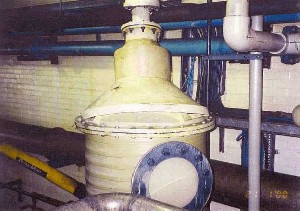At a chemical plant around 8:40 pm, 71 kg of sulphur dichloride (SCl2) were unloaded during a substance transfer operation. The SCl2 was transferred from the steel, nitrogen-inerted container into a tank. This container was connected by a hose to a transfer assembly composed of the tank equipped with a dedicated unloading system and washing column. A pump then channelled product until reaching the transfer capacity. This set-up represented the first implementation of such a process adapted to SCl2. During the day, a leak had been detected on this line. Once repairs had been completed, the SCl2 transfer operation into the tank was underway. After 3 failed attempts, the N2 line, with a pressure limited to 500 mbar, was opened in order to facilitate the transfer and start the pump. This operation was successful, yet the spring balances on the T34 tank indicated that the capacity weighed 200 kg more than expected. Assuming a new technical problem had occurred, technicians once again inspected the transfer line. A few minutes after initiating the transfer, smoke was detected around the relief valve. When the pump stopped, this smoke release ceased. The transfer was interrupted, but shortly thereafter, the head of the washing column broke. A water curtain was activated to prevent the gas from spreading. The emissions of HCl and SO2 stemmed from the hydrolysis of SCl2 in contact with a small quantity of water accidentally present in the tank. The exothermic reaction explained the observed temperature rise (from 50°C to the boiling point). According to the investigation, the unit using this process for the first time had been rinsed with monochlorobenzene (MCB). The pump-transfer capacity section therefore contained traces of MCB. One of the MCB barrels in use had been fouled by a significant quantity of water (35%). The authorities determined that this accident resulted in no casualties or environmental damage. Property damage was limited to the washing column head and ancillary equipment. System restart was contingent upon agency authorisation; authorities requested an assessment of: task organisation (steps performed during normal operating hours), raw material quality (eventual incompatibilities), installation design (specific to given substances, automatic system shutdown triggered by measurement deviations, etc.).
Download the detailed report in .pdf format (1.3 Mb)





